Preserve Your Family Memories
8mm and 16mm Film to DVD in Kansas City, MO
In Kansas City, old film reels in your closets and attics hold family memories that fade a little more each year. This page covers 8mm and 16mm film to DVD conversion for home movies shot decades ago. We explain what to expect when you bring us your reels, how the transfer process protects each frame, and how to keep your films safe until you're ready. Our video duplication service helps Kansas City families turn brittle film into digital files you can watch and share.
Why 8mm Film Should Be Converted Before It Deteriorates
Your 8mm and 16mm reels from the 1960s through the 1980s won't last forever. Film base becomes brittle as it ages. Colors fade to pink or yellow. Splices come apart. Missouri's humidity speeds up this breakdown, especially when reels sit in basements where moisture collects. Once film reaches a certain point, it tears when you try to run it through a projector or scanner.
We see reels every week that families stored for 30 or 40 years. The film that stayed in climate-controlled spaces usually transfers without problems. The reels from damp basements or hot attics show visible damage. Mold appears as white spots. Vinegar syndrome makes the film smell sour and feel sticky.
Converting your film to DVD stops the deterioration. You get a stable digital copy that won't degrade. Your original reels stay safe in storage as backups. Waiting five more years can mean the difference between a clean transfer and a damaged one that costs more to repair.
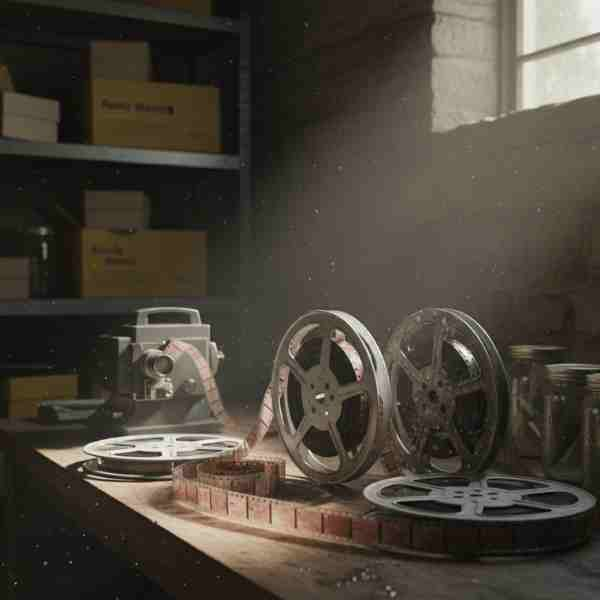
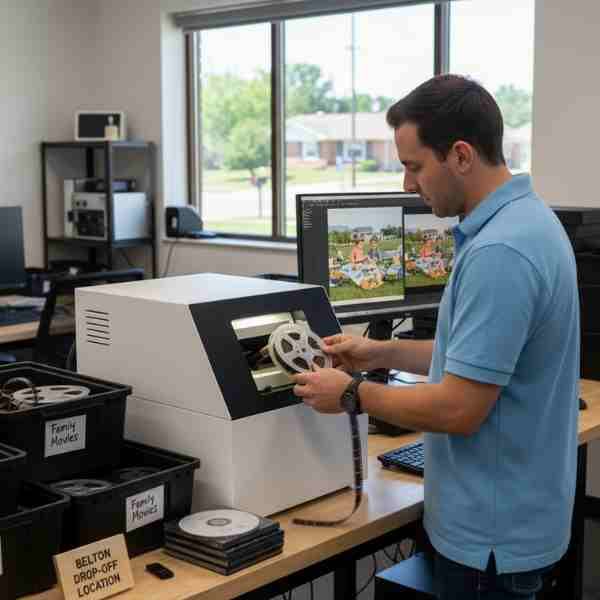
How 8mm and 16mm Film Transfer Works in Kansas City
We use a frame-by-frame scanner that captures each image on your film without pulling it through sprockets that can tear weakened reels. This method works for Standard 8mm, Super 8mm, and 16mm formats. The scanner adjusts for different frame rates so your footage plays at the right speed.
You can drop off your reels at our Belton location or mail them with tracking. We inspect each reel for damage before scanning. If the film needs cleaning or repair, we handle that first. Many Kansas City homes store film in attics where summer heat warps the plastic reels and makes film curl. We flatten and stabilize the film before transfer.
The scanner converts each frame to a digital file. We color-correct faded footage and adjust brightness. You receive DVDs with simple menus that let you navigate between reels. We also put your digital files on a USB drive so you can make copies or share them with family. Your original reels come back to you in the same boxes you brought them in.
What Damaged Film Reels Can Still Be Saved
Torn sprocket holes, broken splices, and mold growth don't always mean your film is lost. We repair most damage before scanning. Small tears get reinforced with archival tape. Missing sprocket holes can be bypassed with our frame-by-frame scanner that doesn't rely on sprockets to advance the film.
Mold appears as white or gray patches on film stored in damp spaces. Older homes in Historic Northeast often have basements or crawl spaces where humidity sits above 60 percent year-round. That moisture feeds mold growth on film emulsion. We clean mold with special solutions that don't harm the image layer.
Vinegar syndrome happens when film base breaks down and releases acetic acid. The film smells like vinegar and feels sticky. If caught early, we can transfer the footage before it becomes too fragile. Film that has fully deteriorated into a gummy block can't be saved.
Bring your damaged reels in for inspection. We'll tell you what can be rescued and what the repair work involves. Most torn or moldy film transfers successfully after cleaning and splicing.
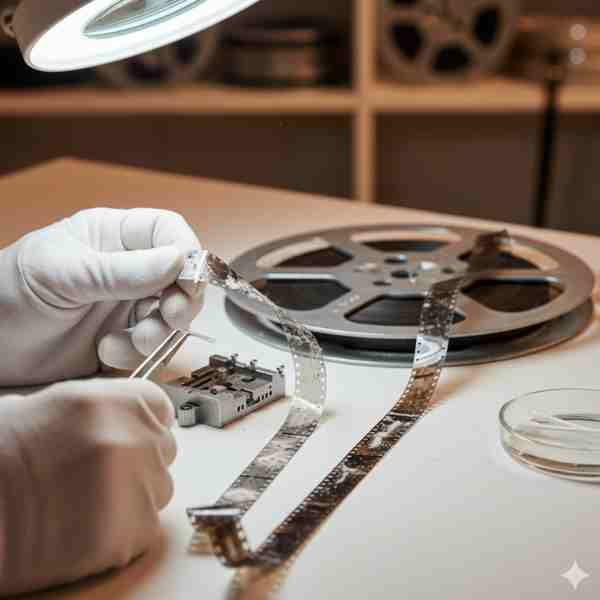
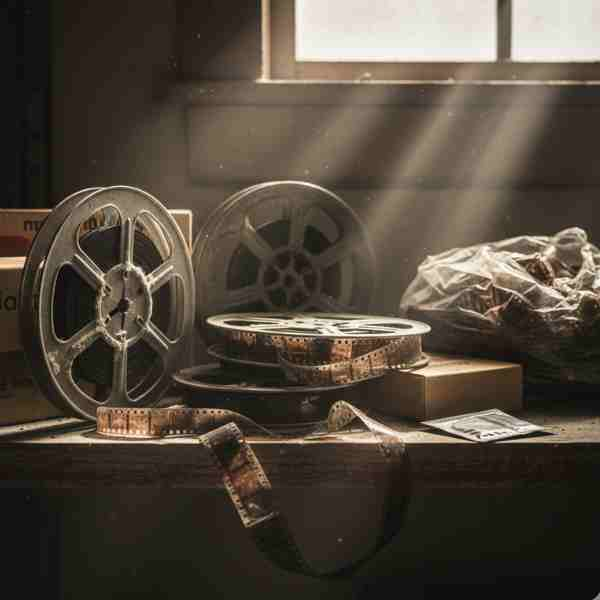
When Your Old Film Reels Are Ready for Digital Transfer
Film that's 30 to 50 years old sits in a critical window. It's old enough to show wear but still flexible enough to scan without breaking. Wait too long and the film becomes so brittle it snaps under its own weight.
Check your reels for warning signs. If the film feels stiff when you unwind a few inches, transfer it soon. If you see cracks along the edges or the film has a strong chemical smell, don't wait. Summer heat in Kansas City garages accelerates aging by softening the film base and then making it brittle when it cools.
Reels stored in their original boxes with silica packets tend to last longer. Film kept loose in plastic bags or cardboard often shows more damage. Temperature swings between seasons cause the most harm.
If you're planning a family reunion or memorial service and want to show old footage, schedule your transfer at least a month ahead. That gives us time to handle repairs if your reels need them. Don't risk running vintage film through a projector. One pass through worn sprockets can tear footage that would have transferred perfectly.
How Long Film to DVD Conversion Takes
Most film transfers take two to four weeks from drop-off to pickup. The timeline depends on how many reels you bring and whether they need repair work. A single reel of Standard 8mm runs about three minutes. Super 8mm reels hold up to four minutes. If you have ten reels, that's 30 to 40 minutes of footage to scan frame by frame.
Damaged film adds time. Cleaning mold or splicing breaks can add several days to your project. We don't rush repairs because careless work damages fragile film.
Holiday demand increases across the Kansas City metro in November and December. Families want their transfers finished before gatherings or as gifts. If you're working toward a specific date, drop off your reels six weeks ahead.
You can call to check your project status anytime. We'll let you know if we find damage that needs approval before we proceed. Once scanning finishes, we test every DVD to confirm it plays correctly. Rush service costs extra but gets your project done in one week for undamaged film.
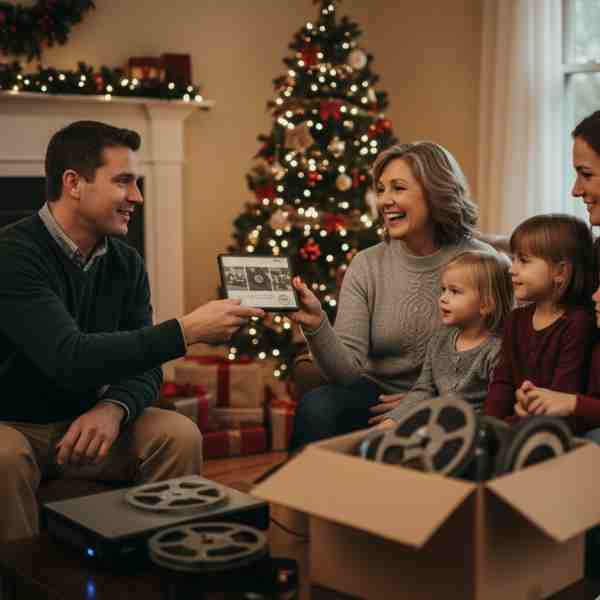
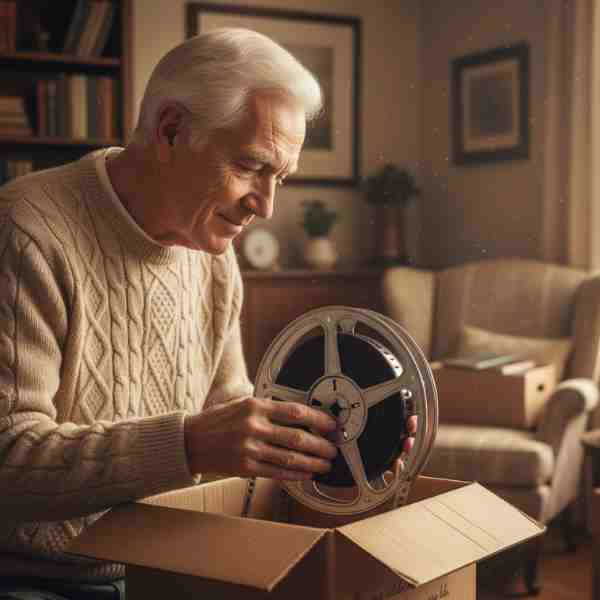
Can 8mm Film Be Converted to DVD in Kansas City?
Yes. Follow these steps to convert your 8mm or 16mm film to DVD:
Inspect your reels for damage or mold
Choose a Kansas City video duplication service
Drop off or mail your reels securely
Technician cleans and repairs film if needed
Film runs through frame-by-frame scanner
Digital files transfer to DVD with menu options
Pick up your original reels and new DVDs
Most transfers finish in two to four weeks depending on reel count and condition.
8mm and 16mm Film to DVD FAQ
Is it safe to mail my 8mm film reels to a Kansas City service?
Yes, mailing your reels is safe if you pack them properly in padded boxes with tracking. Wrap each reel in bubble wrap and fill empty spaces so reels don't shift during transit. Use a carrier that provides tracking numbers so you can monitor delivery. We recommend insuring packages that contain irreplaceable family footage.
Can damaged 8mm film from my Kansas City basement be saved?
Most torn or moldy film can be repaired before transfer. We clean mold growth with archival-safe solutions and splice broken sections with reinforced tape. Film stored in damp basements often shows surface mold but the images underneath remain intact. Bring your reels in for inspection so we can tell you what's salvageable.
How long before my old film reels can't be converted anymore?
Film over 50 years old may become too fragile to transfer within 5 to 10 years. Brittleness increases as the film base breaks down. Once film reaches advanced vinegar syndrome or crumbles when handled, it can't be run through scanning equipment. Transfer your reels now while they're still flexible enough to work with.
What's the difference between 8mm and 16mm film conversion?
16mm film has higher image quality because of its larger frame size, but both formats transfer the same way through frame-by-frame scanning. Standard 8mm and Super 8mm were common for home movies. 16mm was used for professional and educational films. All three formats produce clear digital files when scanned properly.
Where in Kansas City can I drop off 8mm film for DVD transfer?
Look for local video duplication services with in-person drop-off options. We're located in Belton at 8437 Clint Dr and accept film reels during business hours. You can also mail your reels if drop-off isn't convenient. Call ahead to confirm hours and ask about current turnaround times.
What should I do with my original reels after conversion?
Store your original reels in a cool, dry place as backup copies. Keep them in their cases or archival boxes away from temperature extremes. Attics and basements with humidity swings will continue to damage film even after you have digital copies. A climate-controlled closet works better for long-term film storage.

Don't wait for your old 8mm film, slides or VHS tapes to fade away. Call or contact Picture This Video Inc now for a free estimate and quick, reliable service.
Monday - Friday: 8am - 5pm
Saturday & Sunday: Closed
Powered By Local Biz Domination
